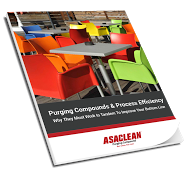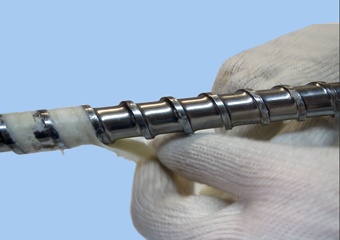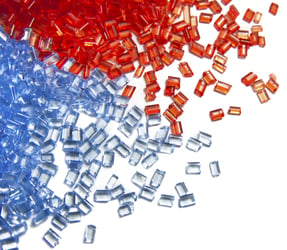
I recently worked on a purge project with one of the leading manufacturers of waste handling and recycling equipment. They compound various colored micro pellets out of proprietary blends of Polyethylene (PE). They were frequently experiencing hours of machine downtime due to contamination building up over time and specifically clogging up numerous small holes of a low-pressure strand die, when making color changes. This large die has thousands of tiny holes. They were looking for something to facilitate color changes without having to tear down the die, reduce the frequency of tear downs overall, and minimize wear/tear to pro-long the life of it.
We examined their processing and purging conditions to get a better understanding of what was causing the contamination to clog up the holes. To name just a few of them, we considered factors such as the melt index range of their production materials, processing temperatures of their production material for all zones and the tolerance of the holes.
They experimented with different mechanical purge compounds unsuccessfully over the years. These mechanical purges (works off of agitation and turbulence) were ineffective and provided no benefit. They found the most successful and beneficial method was to stop production, tear down and manually clean it to remove the contamination out of the holes. To help this company enhance their process, I had him implement these easy and quick, yet extremely effective, steps:
1. Use a heat-activated chemical purge compound (works off of heat and containment), instead of a mechanical purge compound, to remove contamination out of the holes of the low-pressure die.
2. Maintain their elevated operating production processing temperatures (in this case they were already at high enough heats for sufficient foaming activity) in all zones after the end of extruder, to try to help remove the contamination more quickly.
3. Pre-flush the compounding machine with clean, natural extrusion grade HDPE that is at least as stiff as the production material.
4. Empty the system of the pre-flush resin, and add one full system capacity of the purge compound at normal screw speed until the purge extrudes uniformly from the die head.
5. Contain the purge in the system with the screw at minimum controllable RPM (barely turning) for around 20 minutes, so that expansion of the purge compound would occur.
6. Empty the purge out of system at normal screw speed with next production material and wait a short period of time for the chemical purge compound residue to break down.
They recently reported back that they facilitated a color change without having to tear the die down, successfully removed contamination out of the holes of the die, decreased machine downtime/lost opportunity by 2.5 hours and maintained head pressure for longer. As a result, they will enhance the overall control of the process, reduce wear and tear of the die and extend the life of it.
Ready to learn more about how to achieve successful resin transitions without residue? Discover why purging compounds and process efficiency must work in tandem.

Ben Moore brings over 20 years of experience as a Purging Expert at Asaclean Purging Compounds, a leading manufacturer and distributor of purging compounds. As part of Asahi Kasei Plastics North America, Inc. (APNA), Ben has personally assisted hundreds of customers, helping them achieve significant cost savings. Based in Parsippany, NJ, Ben specializes in optimizing operations for thermoplastic injection molding, extrusion, compounding, and blow molding processes. His expertise lies in maximizing production efficiency by minimizing downtime and reducing scrap. For those interested in trying Asaclean products or seeking expert guidance, feel free to contact Ben directly. You can contact him at 800-787-4348, extension 227, or via email at bmoore@asaclean.com.








Comments